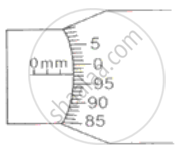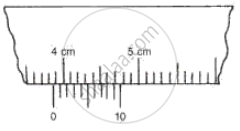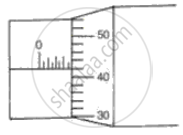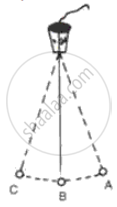Advertisements
Online Mock Tests
Chapters
![Frank solutions for Physics [English] Class 9 ICSE chapter 1 - Measurement Frank solutions for Physics [English] Class 9 ICSE chapter 1 - Measurement - Shaalaa.com](/images/physics-english-class-9-icse_6:1a0f7706074c4feda1fb5ca0ff12ac66.jpg)
Advertisements
Solutions for Chapter 1: Measurement
Below listed, you can find solutions for Chapter 1 of CISCE Frank for Physics [English] Class 9 ICSE.
Frank solutions for Physics [English] Class 9 ICSE 1 Measurement Exercise 1 [Pages 15 - 16]
What is meant by measurement?
Define a fundamental quantity.
Name the three fundamental quantities.
What do you mean by the term unit?
Define standard meter.
Name three systems of unit and state various fundamental units in them.
Name the SI unit of mass and define it.
Name three units of length which are bigger than a meter. How are they related to the meter?
What are the fundamental units in SI system? Name them along with their symbols.
What do you mean by light year?
Exercise
Which of the following is not a unit of distance?
Leap year
parsec
light year
Angstrom
Complete the rollowing:
1 fermi __________ m
Complete the rollowing:
1 m = ____ Å
Complete the rollowing:
1 parsec= _____ ly
Complete the rollowing:
1 light year= ________ m
Complete the rollowing:
1 m = ____ μ.
Complete the rollowing:
1 micron= ____ Å
Complete the rollowing:
1 u = ____ kg
State two units of mass smaller than a kilogram?
What is a leap year?
The Wavelength of a particular colour is 5400Å. Express it in nanometer and metre.
The size of bacteria is 2 μ.. Find the number of bacteria in 3 m length.
Complete the following: 1 quintal =………kg
Complete the following : 1 mg =………kg
Complete the following:
1 mean solar day = _______ s.
Complete the following: 1 nano second =……….s.
Complete the following: 1 year =……….s.
Frank solutions for Physics [English] Class 9 ICSE 1 Measurement Exercise 2 [Pages 28 - 30]
Explain the term pitch. How are they determined?
Explain the term least count of a screw gauge. How are they determined?
What do you mean by zero error of a screw gauge? How is it accounted for?
What is the backlash error?
How the backlash error is avoided?
In the following figure, the pitch of the screw is 1 mm. Calculate:
(i) the least count of screw gauge and
(ii) the reading represented in the figure.

Name the instrument which has the least count
0.1 mm
Name the instrument which has the least count
1 mm
Name the instrument which has the least count
0.01 mm
Name the measuring employed to measure the diameter of a needle.
Name the measuring employed to measure the thickness of a paper.
Name the measuring employed to measure the diameter of a pencil.
While measuring the length of a rod with a vernier callipers, below shows the position of its scales. What is the length of the rod?

State whether the following statement is true or false by writing T/F against it.
The diameter of a wire can be measured more accurately by using vernier calipers than by a screw gauge.
True
False
State whether the following statement is true or false by writing T/F against it.
The least count of a screw gauge can be lowered by increasing the number of divisions on its thimble.
True
False
State whether the following statement is true or false by writing T/F against it.
A metre scale can measure a length of 6.346 cm.
True
False
State whether the following statement is true or false by writing T/F against it.
The ratchet of a screw gauge is used to measure the depth of a beaker.
True
False
State whether the following statement is true or false by writing T/F against it.
The metre scale, vernier calipers, and screw gauge are in decreasing order of least count.
True
False
Express 1 liter in terms m3.
A screw has a pitch equal to 0.5 mm. What should be the number of divisions on its head so as to read correctly up to 0.001 mm with its help?
The following Figure shows the reading obtained while measuring the diameter of a wire using a screw gauge. The screw advances by 1 division on the main scale when the circular head is rotated once. Calculate:
(i) the pitch of the screw gauge,
(ii) Least count of the screw gauge, and

(iii) The diameter of the wire.
Frank solutions for Physics [English] Class 9 ICSE 1 Measurement Exercise 3 [Page 38]
What is a seconds pendulum?
What do you mean by an oscillation?
Is there any relation between oscillation and amplitude?
A person sitting on a swing stands up. The time period of swing:
Increases
decreases
Does not change
become zero
Moon has no atmosphere and acceleration due to gravity at its surface is one-sixth that at the earth's surface. When a pendulum is taken from earth to moon surface, its time period will:
Increase
decrease
Not change
becomes infinite.
Frank solutions for Physics [English] Class 9 ICSE 1 Measurement Exercise 4 [Page 44]
What is the least count in the case of the following instrument?
Metre scale
What is the least count in the case of the following instrument?
vernier calipers
What is the least count in the case of the following instrument?
Screw gauge
What is the least count in the case of the following instrument?
Stopwatch
What is the least count in the case of the following instrument?
Thermometer
What is the least count in the case of the following instrument?
Spring balance
Which of the following measurement is most accurate?
3000 g
3.0 kg
3.00 kg
3 kg
Is there any difference in the following measurements?
(a) 51.7 cm
(b) 51.70 cm
(c) 51.700 cm.
Explain your answer.
Which measurement is most accurate?
Frank solutions for Physics [English] Class 9 ICSE 1 Measurement Exercise 5 [Pages 46 - 50]
What are the fundamental units?
Define standard meter.
Name the SI unit of electric current.
Define the least count of an instrument.
Define the time period of a simple pendulum,
Express micron in terms of meter.
Express light year in terms of meter.
Consider the following case where the zero of vernier scale and the zero of the main scale are clearly seen. If L.C. of the vernier calipers is 0.01 cm, write the zero error and zero correction of the following.

Consider the following case where the zero of vernier scale and the zero of the main scale are clearly seen. If L.C. of the vernier calipers is 0.01 cm, write the zero error and zero correction of the following.

Consider the following case where the zero of vernier scale and the zero of the main scale are clearly seen. If L.C. of the vernier calipers is 0.01 cm, write the zero error and zero correction of the following.

What is the zero error of a screw gauge?
The following figure shows the reading of a vernier caliper used for measuring the thickness of a metal sheet.
(i) Find the least count of the instrument.
(ii) Calculate the thickness of the metal sheet.

What is meant by the pitch of a screw gauge? The pitch of a screw is 1 mm.
Find the reading of the instrument shown in the following figure.

Define the following terms with reference to a simple pendulum:
Oscillation
Define the following terms with reference to a simple pendulum:
Time period
Define the following terms with reference to a simple pendulum:
Frequency
Define the following terms with reference to a simple pendulum:
Amplitude
If a pendulum takes 0.5 s to travel from A to B as shown in the following figure, find its time period and frequency.

The following diagrams (Fig. 5) show the use of a vernier caliper under three different situations. Study the diagrams carefully and note down the vernier readings in each case.

(a) Measuring the diameter of the rod

(b) Measuring Internal diameter of a cavity

(c) Measuring depth of a cavity
What are the fundamental units in the SI system? Name them along with their symbols.
What are the rules observed while writing the unit of a physical quantity?
Describe the procedure to measure the diameter of a wire with the help of a screw gauge.
Define the following terms with reference to a simple pendulum:
Oscillation
Define the following terms with reference to a simple pendulum:
Amplitude
Define the following terms with reference to a simple pendulum:
Frequency
Define the terms : time period as related to a simple pendulum.
Draw a neat diagram of a simple pendulum. Show on it the effective length of the pendulum and its one oscillation .
What is a simple pendulum?
Name the factors on which the time period of a simple pendulum depends. Write the relation for the time period in terms of the above named factors.
Show how will you use the physical balance to measure the mass of an object.
Mention three precautions that you would observe to measure the mass of a body using a beam balance.
State two conditions for a beam balance to be true.
Solutions for 1: Measurement
![Frank solutions for Physics [English] Class 9 ICSE chapter 1 - Measurement Frank solutions for Physics [English] Class 9 ICSE chapter 1 - Measurement - Shaalaa.com](/images/physics-english-class-9-icse_6:1a0f7706074c4feda1fb5ca0ff12ac66.jpg)
Frank solutions for Physics [English] Class 9 ICSE chapter 1 - Measurement
Shaalaa.com has the CISCE Mathematics Physics [English] Class 9 ICSE CISCE solutions in a manner that help students grasp basic concepts better and faster. The detailed, step-by-step solutions will help you understand the concepts better and clarify any confusion. Frank solutions for Mathematics Physics [English] Class 9 ICSE CISCE 1 (Measurement) include all questions with answers and detailed explanations. This will clear students' doubts about questions and improve their application skills while preparing for board exams.
Further, we at Shaalaa.com provide such solutions so students can prepare for written exams. Frank textbook solutions can be a core help for self-study and provide excellent self-help guidance for students.
Concepts covered in Physics [English] Class 9 ICSE chapter 1 Measurement are Unit Systems, International System of Units (Si System), Vernier Callipers, Simple Pendulum for Time, Measurements Using Common Instruments, Measurements, Physical Quantities, Unit and Its Types, Unit Prefixes, Measuring Smaller Distances, Measuring Larger Distances, Measurement of Time, Rules and Conventions for Writing SI Units and Their Symbols, Principle of Vernier, Screw Gauge, Principle of Screw Gauge, A Time Period of Oscillation and Frequency, Measurement of Length, Measurement of Mass.
Using Frank Physics [English] Class 9 ICSE solutions Measurement exercise by students is an easy way to prepare for the exams, as they involve solutions arranged chapter-wise and also page-wise. The questions involved in Frank Solutions are essential questions that can be asked in the final exam. Maximum CISCE Physics [English] Class 9 ICSE students prefer Frank Textbook Solutions to score more in exams.
Get the free view of Chapter 1, Measurement Physics [English] Class 9 ICSE additional questions for Mathematics Physics [English] Class 9 ICSE CISCE, and you can use Shaalaa.com to keep it handy for your exam preparation.
